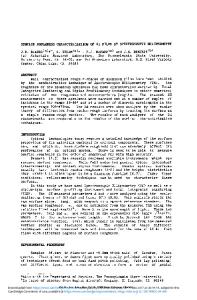Evaluation of Magnesium Oxide Films by Spectroscopic Ellipsometry
- PDF / 194,831 Bytes
- 6 Pages / 612 x 792 pts (letter) Page_size
- 3 Downloads / 363 Views
Evaluation of Magnesium Oxide Films by Spectroscopic Ellipsometry Hiroshi Kimura Device Analysis Technology Laboratories, NEC Corporation, 1753 Shimonumabe, Nakahara-ku, Kawasaki, Kanagawa, 211-8666, JAPAN ABSTRACT Spectroscopic ellipsometry was used to evaluate the density and surface roughness of MgO films. The density of a film affects the dispersion of the film’s refractive index, and the refractive index can be evaluated by spectroscopic ellipsometry. Among the various fitting models applied to all of the deposited films, the two-layered model gave the best results. For the two-layered model, we found that the thickness of the upper layer was strongly correlated with surface roughness. Thus, spectroscopic ellipsometry can be used to evaluate density and roughness. INTRODUCTION The plasma display panel (PDP) is a promising devices for use in large-area displays. Its required characteristics are long lifetime and low operating voltage [1]. The lifetime of a PDP is determined from the sputtering yield of MgO thin film [2], and this yield is directly affected by the film’s density [3]. The firing and sustaining voltage depend on the secondary electron emission coefficient of MgO [4], and both voltages are lower when the surface is smooth [5]. The properties of a MgO film, such as its density and surface roughness, depend strongly on the deposition condition. Thus, to manufacture good PDPs, the MgO deposition process should be monitored continuously, but there is no suitable method to evaluate the process monitoring technique. The monitoring method should be simple, fast, and reliable while being nondestructive. The dispersion of a film’s refractive index reflects the density and surface roughness of the film. For MgO, they should be determined by measuring the film’s refractive index. This refractive index has been evaluated by spectroscopic ellipsometry [6], which is a non-destructive, simple, and fast tool for analyzing thin films, so it can be applied to process monitoring. In this study, we used spectroscopic ellipsometry to evaluate quantitatively the density and surface roughness of MgO films deposited under various conditions. EXPERIMENTAL About 1 µm of MgO was deposited on a glass substrate by electron beam evaporation. Sample films were prepared by using various oxygen fluxes and substrate temperatures, which are both critical parameters affecting film quality [7, 8, 9]. They ranged from 0 to 100 sccm and 50 to 290°C, respectively, as shown in Table I. Spectroscopic ellipsometry measures the polarization of light reflected from film, where polarization is described by the amplitude ratio of p- to s-component reflectance Ψ and the phase shift Δ. The ratio is described by
Q5.7.1
Table I. Deposition conditions. Sample number
Oxygen flux [sccm]
Substrate temperature [ºC]
#1 #2 #3 #4 #5 #6 #7 #8 #9
0 65 100 0 65 100 0 65 100
50 50 50 200 200 200 290 290 290
(2)
(1)
RP = tan Ψ ⋅ exp i∆ , RS where RP and RS indicate the reflection coefficients for p- and s-polarized light, respectively. Measurements wer
Data Loading...









